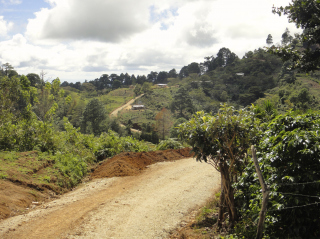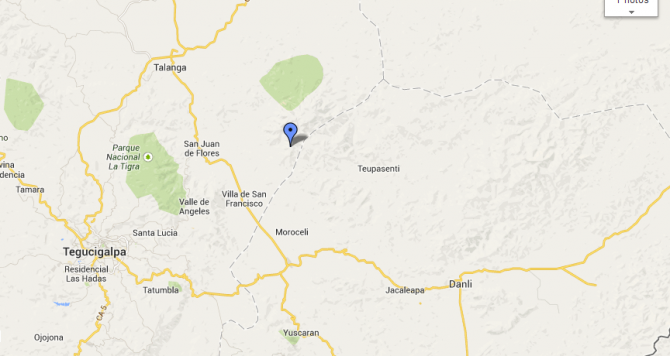Palo Verde, Honduras
![]()
![]()
![]()
![]()
![]()
![]()
![]()
![]()
![]() Click on Programs to learn more about their work in this community
Click on Programs to learn more about their work in this community
General Information

| Population* | 250 |
| Number of homes | 42 |
| Avg # of people per home | 6.0 |
| Primary Occupations | Agriculture - coffee, corn, beans |
| Water System | Yes - Gravity system |
| Community Bank | No - Community members have access to bank in Zurzular |
| % of Homes with Latrines | 25% |
| Electricity | Yes - Solar Power |
| Corresponding Health Center | CESAR - Zurzular |
| Common Illnesses | Common cold, skin infections |
| School Access & Distance | 1st-6th grades in community, 7th-9th grades in Zurzular (20 minute walk) |
| Municipality | San Juan de Flores |
| Department | Francisco Morazán |
| GPS |
N 14° 16.407’ W 086° 50.812’ |
| Distance from compounds | 2 Hours |
| Road conditions | Fair |
* Population does not reflect how many patients will be seen on medical
brigades as many people from surrounding communities come seeking
Medical Brigades medical attention.
Top Three Needs Expressed
The top needs expressed by the key community members are public health infrastructure, public health education, and a health center.


Palo Verde is located at an altitude of 5600 feet in the mountainous municipality of San Juan de Flores. Due to its altitude, the community is often chilly with gusty winds, especially when raining. It lies alongside Global Brigades' first holistic community of El Zurzular, which allows residents to access many Global Brigades' programs not yet implemented in Palo Verde. For example, many children attend school in the secondary school built by architecture brigades.
Palo Verde’s educational system includes a Primary school (until 6th grade). There are 62 students and Dina Carranza is the schoolteacher. It is approximated that about 30% of the community knows how to read and write.
Students can also attend secondary school in the neighboring community of El Zurzular. El Zurzular has a secondary school, which was constructed with the support of Global Brigades' student volunteers.
Prior to 2012, community members in Palo Verde did not have access to potable water. Women and children often needed to walk to distant sources to collect water and then lug it to their homes in buckets and tubs. In March 2012, however, the Global Brigades Water Program entered the community and constructed a gravity-based system connecting roughly 30 households to a source of clean, chlorinated water.
- A. Health
Palo Verde does not have a health center. The closest center is an hour’s walk away in the community of Zurzular where previous Global Medical Brigades have been facilitated. Dental care is non-existent. Community members thus consult with Global Brigades' community health workers for their basic healthcare needs.
Community members also work with the Basic Sanitation Committee, a group tasked with promoting basic hygiene and sanitation habits in the community in order to prevent common illnesses.
The most common illnesses seen by community members are: common colds, parasites, and respiratory problems. Few have latrines that currently function. 0% has eco-stoves (estufas justas). About 0% is estimated to have cement floors.
Below are some health statistics from CESAR-Zurzular2, which is the closest health center to Palo Verde.
I. Annual Morbidities, 2009: CESAR-Zurzular
Centro de Salud Statistics, Centro de Salud Regional-Francisco Morazán, 16 Marzo 2010
The average family income per month is estimated to be 1500 Lempiras, which is approximately L250 (US $13.51) per person3. The majority of homes are made of adobe, straw and mud. The main form of employment is agriculture, and the main products that are cultivated in the community are coffee, corn, and beans. There is no community bank in Palo Verde. However, community members can access credit and savings accounts via the community bank in the neighboring community of El Zurzular. Some community members have even become members of this community bank.
Palo Verde is a hamlet of Zurzular—a community that has implemented all of the Honduran Global Brigades programs. GB has built a strong relationship with Zurzular and hopes extend our partnership by going into neighboring Palo Verde.
Apart from Global Brigades, the only organization working in Palo Verde is ELENOR, a private Spanish renewable energy organization, which is working on a solar panel project for the community.
Source of information: Key informant interview, Centro de Salud statistics
Date of interview: 20 April 2010
1CESAMO and CESAR are terms used for types of health centers. CESAMOs are larger, more comprehensive facilities that usually have a physician on staff at all times and occasionally a dentist. CESARs are more remote, less equipped facilities, usually with 1-2 nurses on staff.
2According to Red Solidaria and World Food Programme in Honduras, the average family is approximated at 5 people per household, the poverty line is L930 (US$49.23) per person per month, and the extreme poverty line is L617 (US$32.66) per person per month.